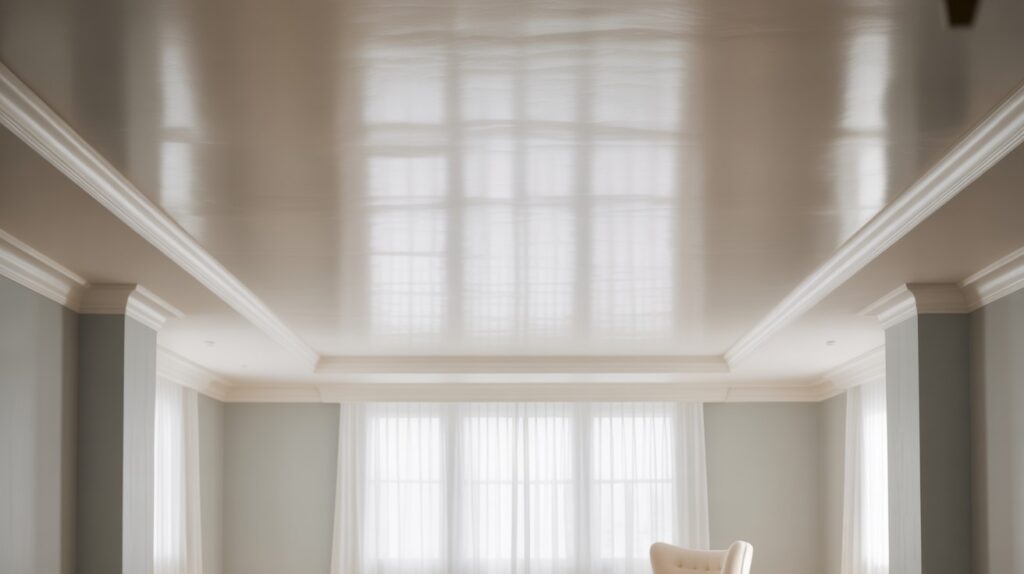You’ve come to the right place if you’re staring at your ceiling wondering which paint to choose. We know it’s confusing – flat paint, eggshell, or that fancy “ceiling formula” everyone mentions? Don’t worry.
In this guide, you’ll learn about:
- Paint finish types and what works best above your head
- Coverage tips to avoid that patchy look
- Common mistakes (so you don’t make them)
Here’s what we’ve learned from painting hundreds of ceilings: there’s no one-size-fits-all answer. But there is a smart way to decide. Whether you’re a weekend warrior or a careful planner, we’ll walk you through how to pick paint that looks amazing and stays that way. No marketing speak. No fancy terms. Just honest advice that works.
Why Ceiling Paint Matters

Let me tell you something most people miss. Your ceiling is like the fifth wall in any room.
I’ve seen homeowners spend hundreds on wall paint, then grab the cheapest white for their ceiling. Big mistake.
Here’s why ceiling paint deserves your attention,
Light changes everything.A good ceiling paint:
- Bounces light around your room
- Makes spaces feel bigger
- Saves you money on electricity
But wait, there’s more to it.
Your ceiling tells stories. All those cracks, water stains, and rough patches? Regular wall paint makes them pop out like neon signs. The right ceiling paint? It pulls a magic trick and makes them disappear.
I painted my own kitchen ceiling last year. Used the wrong finish. Every morning my coffee was interrupted by staring at visible brush marks. Learn from my mistake.
Your ceiling sets the mood. A well-painted ceiling can:
- Make your room feel taller
- Create a cozy atmosphere
- Even hide those DIY drywall patches (we’ve all been there)
Don’t ignore your ceiling. It’s working hard up there.
Ceiling Paint vs. Wall Paint: What’s the Difference?
Most people think paint is paint. I used to think that too. Big mistake.
Here’s what you need to know.
Ceiling paint is thicker. Much thicker. Like honey compared to milk. This viscosity helps it stick better overhead and drip less. Ever had paint rain on your face? I have. Never again.
The finish matters way more than you think.
Wall paint comes in:
- Glossy (reflects everything)
- Semi-gloss (shows some shine)
- Satin (subtle glow)
- Eggshell (slight luster)
- Flat (no shine at all)
Ceiling paint? Usually flat or ultra-flat only. Why? Those smooth finishes hide imperfections. Your ceiling isn’t perfect. Nobody’s is.
Coverage is different too.
Wall paint often needs two coats for good results. Ceiling paint? It’s designed to:
- Cover in one thick coat
- Minimize roller marks
- Stick to textured surfaces
I learned this the hard way. Used leftover wall paint on my garage ceiling. Three coats later, I could still see the old color through it.
Pro tip: Some ceiling paints have pink undertones. They look pink in the can but dry pure white. This helps you see where you’ve painted. Smart, right?
Don’t mix them up. Your walls and ceiling have different jobs. Give them the right tools.
Key Factors to Consider When Choosing Ceiling Paint
Picking the right ceiling paint isn’t random. I’ve made enough mistakes to know what matters.
1. Type of Room
Not all rooms are created equal. Your bathroom ceiling faces different challenges than your bedroom.
For steamy spots like kitchens and bathrooms:
- Mold resistance is crucial
- Moisture-proof formulas work best
- I use paint with anti-bacterial properties
For dry spaces like bedrooms and living rooms:
- Standard ceiling paint works fine
- Focus on color and finish
- Don’t overpay for features you don’t need
2. Ceiling Material
What’s above you matters more than you think.
Drywall: The easy one. Most paints stick naturally.
Plaster: Older homes often have this. Needs special primer usually.
Textured (like popcorn): Thicker paint helps. Uses more too.
Acoustic tiles: These drink up paint. Get extra.
I once tried painting acoustic tiles with regular wall paint. Disaster. It took four coats. Still looked patchy.
3. Lighting in the Room
Light plays tricks on your ceiling.
Natural light coming in?
- Flat paint prevents glare
- South-facing rooms need careful color choice
- Morning sun exposes every imperfection
Mostly artificial light?
- Consider your bulb type
- LED lights can make some whites look blue
- Incandescent bulbs make whites appear warmer
4. Color Choice
Most ceilings are white. Here’s why.
Standard white benefits:
- Reflects maximum light
- Makes rooms feel taller
- Covers old stains easily
Current trends I’m seeing:
- Soft grays
- Same color as walls (bold move)
- Classic blue in dramatic rooms
Don’t go too wild. Your ceiling sees you every day.
5. Finish (Sheen Level)
This choice can make or break your project.
Flat finish:
- Hides imperfections beautifully
- No glare or reflection
- Hard to clean (wipe carefully)
Matte finish:
- Almost flat with tiny bit of shine
- Slightly easier to wipe
- Still pretty forgiving
Eggshell:
- Too shiny for most ceilings
- Use only on perfect surfaces
- Better for accent areas
I stick with flat for 99% of ceilings. It’s the safe choice that works.
Best Types of Paint for Ceilings
Let me break down the ceiling paint lineup for you. Each type has its place.
1. Flat/Matte Paint – Most Common
This is your workhorse. Your daily driver. Most ceilings get this treatment.
Why flat paint rocks:
- Zero reflection means fewer visible flaws
- Absorbs light instead of bouncing it
- Great for standard rooms
- Costs less than fancy formulas
I use flat paint on 90% of my ceiling jobs. It just works.
2. Paint and Primer in One
Don’t believe the hype about skipping primer every time. Here’s the truth,
Use paint and primer in one when:
- Your ceiling hasn’t been painted before
- You’re going from dark to light colors
- Previous paint is in good shape
- You want to save time
Skip it when:
- Your ceiling has water stains
- You’re covering nicotine buildup
- Old paint is peeling
- Surface needs serious prep
I keep both regular and combo versions in my garage.
Stain-blocking Paints – for smoke or water stains
These paints are problem solvers. Your backup plan.
When you need stain-blockers:
- Yellow water marks won’t go away
- Smoke damage from years of candles
- Nicotine stains from previous owners
- Crayons on the ceiling (kids get creative)
They cost more but save headaches. Trust me, regular paint won’t cover that smoke stain no matter how many coats you apply.
3. Moisture-resistant Paints
These are specialized athletes. Made for humid environments.
For steamy rooms:
- Mold and mildew resistance built-in
- Withstand moisture better
- Don’t peel when bathrooms get hot
- Work great in laundry rooms too
I once painted a bathroom ceiling with regular paint. Big mistake. Within six months, I had mold spots from all the shower steam.
Pick your paint based on your problem, not just price.
Tips for a Flawless Ceiling Paint Job
After painting countless ceilings, here’s what I’ve learned the hard way.
1. Use the Right Tools
Forget fancy gadgets. You need basics done right:
- 3/8″ roller for smooth ceilings, 1/2″ for textured
- Extension pole (your neck will thank you)
- Paint tray with grid
- Skip foam rollers – they create bubbles
I spent years hurting my neck before buying that $20 extension pole. Don’t be stubborn like me.
2. Prep Work Matters
Clean properly:
- Wipe dusty surfaces with damp cloth
- Remove cobwebs (they’ll show through paint)
- Fix cracks and holes now
Tape carefully:
- Blue painter’s tape on edges
- Press down hard to seal
- Remove while paint is still wet
Prime when needed:
- Water stains need blocking primer
- New drywall always requires primer
- Dark to light colors? Prime first
I once skipped priming over water stains. They showed through 3 coats. Learn from my mistake.
3. Apply with Proper Technique
Your technique prevents headaches:
- Roll in grid pattern (not back and forth)
- Keep a wet edge
- Work in 4×4 foot sections
- Don’t overload the roller
Avoid these killers:
- Rolling too fast creates splatter
- Pressing too hard causes drips
- Painting over semi-dry spots leaves lines
Slow and steady wins here. Rush it and you’ll cry.
4. Work with Natural Light
Light reveals everything:
- Paint on cloudy days (best diffused light)
- Open all blinds and curtains
- Use work light from side to catch missed spots
Morning light shows every flaw. Don’t paint only under artificial light.
Quick test: paint a small section first in natural light. It’ll show you what to expect.
Conclusion
After years of ceiling painting mistakes, here’s the simple truth: your ceiling matters more than you think. It’s your fifth wall, setting the mood and light in every room.
Choose your paint based on your room type – bathrooms need moisture resistance, bedrooms can use standard formulas. Pick the right finish (flat is usually best) and don’t cheap out on quality. Brands like Sherwin-Williams Eminence and Benjamin Moore deliver, while Behr works for budget projects.
Use the right tools – 3/8″ roller, extension pole, painter’s tape. Prep matters: clean, fix, prime if needed. Apply in grid patterns, work in 4×4 sections, and paint in natural light to catch imperfections.
The real secret? Take your time. Rush a ceiling job and you’ll stare at mistakes forever. Do it right once and enjoy the results for years. Your future self will thank you for the effort.
Frequently Asked Questions
Do I really need special ceiling paint or can I use regular wall paint?
While you can use wall paint on ceilings, it’s a mistake. Ceiling paint is thicker, has better splatter resistance, and is designed for flat finishes that hide imperfections. Regular wall paint might require multiple coats and show roller marks easily.
What’s the best paint sheen for ceilings?
Flat paint is best for most ceilings. It hides imperfections, reduces glare, and creates an even appearance. Matte is acceptable for easier cleaning, but avoid eggshell or satin finishes unless you have perfect ceiling surfaces.
Should I use paint with primer built-in for ceilings?
It depends. Use paint-and-primer combo for previously painted ceilings in good condition. For new drywall, water stains, or significant color changes, use separate primer first to ensure proper coverage and stain blocking.
How much ceiling paint do I need per room?
A gallon covers 350-400 square feet. For a 12×15 room (180 sq ft ceiling), you’ll need about 1/2 gallon. Always buy extra – it’s cheaper than running out mid-job and dealing with color variations.
How do I avoid lap marks and visible roller patterns?
Work in 4×4 foot sections, maintain wet edges, and roll in a grid pattern rather than back and forth. Use an extension pole to keep consistent pressure and always check your work in natural light to catch missed spots.

